Related Research Articles
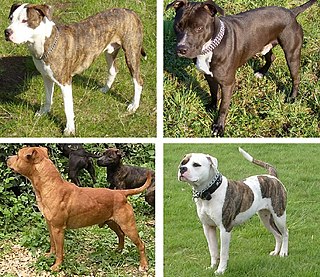
Pit bull is an umbrella term for several types of dog believed to have descended from bull and terriers. In the United States, the term is usually considered to include the American Pit Bull Terrier, American Staffordshire Terrier, American Bully, Staffordshire Bull Terrier, and sometimes the American Bulldog, along with any crossbred dog that shares certain physical characteristics with these breeds. In other countries, including the United Kingdom, the term is used as an abbreviation of the American Pit Bull Terrier breed specifically, while the Staffordshire Bull Terrier is not considered a pit bull. Most pit bull–type dogs descend from the British bull and terrier, a 19th-century dog-fighting type developed from crosses between the Old English Bulldog and the Old English Terrier.

The Staffordshire Bull Terrier, also called the Staffy or Stafford, is a purebred dog of small to medium size in the terrier group that originated in the northern parts of Birmingham and in the Black Country of Staffordshire, for which it is named. They descended from 19th-century bull terriers that were developed by crossing bulldogs with various terriers to create a generic type of dog generally known as bull and terriers. Staffords share the same ancestry with the modern Bull Terrier, although the two breeds developed along independent lines, and do not resemble each other. Modern Staffords more closely resemble the old type of bull terrier, and were first recognised as a purebred dog breed by The Kennel Club of Great Britain in 1935.
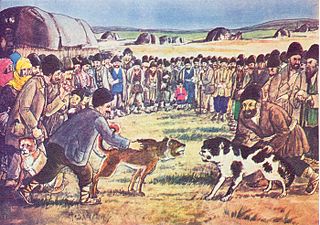
Dog fighting is a type of blood sport that turns game and fighting dogs against each other in a physical fight, often to the death, for the purposes of gambling or entertainment to the spectators. In rural areas, fights are often staged in barns or outdoor pits; in urban areas, fights are often staged in garages, basements, warehouses, alleyways, abandoned buildings, neighborhood playgrounds, or in the streets. Dog fights usually last until one dog is declared a winner, which occurs when one dog fails to scratch, dies, or jumps out of the pit. Sometimes dog fights end without declaring a winner; for instance, the dog's owner may call the fight.

In law, breed-specific legislation (BSL) is a type of law that prohibits or restricts particular breeds or types of dog. Such laws range from outright bans on the possession of these dogs, to restrictions and conditions on ownership, and often establishes a legal presumption that such dogs are dangerous or vicious to prevent dog attacks. Some jurisdictions have enacted breed-specific legislation in response to a number of fatalities or maulings involving pit bull–type dogs or other dog breeds commonly used in dog fighting, and some government organizations such as the United States Army and Marine Corps have taken administrative action as well. Due to opposition to such laws in the United States, anti-BSL laws have been passed in 21 of the 50 state-level governments, prohibiting or restricting the ability of jurisdictions within those states to enact or enforce breed-specific legislation.
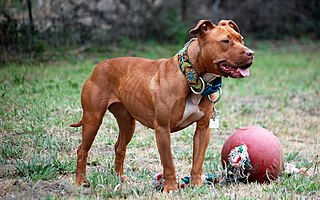
The American Pit Bull Terrier (APBT) is a dog breed recognized by the United Kennel Club (UKC) and the American Dog Breeders Association (ADBA), but not the American Kennel Club (AKC). It is a medium-sized, short-haired dog, of a solid build, whose early ancestors came from England. When compared with the English Staffordshire Bull Terrier, the American Pit Bull Terrier is larger by margins of 6–8 inches (15–20 cm) in height and 25–35 pounds (11–16 kg) in weight. The American Pit Bull Terrier varies in size: males are normally about 18–21 inches (45–53 cm) in height and around 35–60 pounds (15–27 kg) in weight, while females are normally around 17–20 inches (43–50 cm) in height and 30–50 pounds (13–22 kg) in weight.

The American Staffordshire Terrier, also known as the AmStaff, is a medium-sized, short-coated American dog breed recognized by the American Kennel Club, but not the United Kennel Club, which instead allows American Staffordshire Terriers to be registered under the American Pit Bull Terrier breed.

The Bull Terrier is a breed of dog in the terrier family. There is also a miniature version of this breed which is officially known as the Miniature Bull Terrier. This breed originates in 19th century England. Bull Terriers are most recognised by their unique head features. The Bull Terrier was originally bred for vermin control and bloodsports.
In some countries there is an overpopulation of pets such as cats, dogs, and exotic animals. In the United States, six to eight million animals are brought to shelters each year, of which an estimated three to four million are subsequently euthanized, including 2.7 million considered healthy and adoptable. Euthanasia numbers have declined since the 1970s, when U.S. shelters euthanized an estimated 12 to 20 million animals. Most humane societies, animal shelters and rescue groups urge animal caregivers to have their animals spayed or neutered to prevent the births of unwanted and accidental litters that could contribute to this dynamic.

Bull and terrier was a common name for crossbreeds between bulldogs and terriers in the early 1800s. Other names included half-and-halfs and half-breds. It was a time in history when, for thousands of years, dogs were classified by use or function, unlike the modern pets of today that were bred to be conformation show dogs and family pets. Bull and terrier crosses were originally bred to function as fighting dogs for bull- and bear-baiting, and other popular blood sports during the Victorian era. The sport of bull baiting required a dog with attributes such as tenacity and courage, a wide frame with heavy bone, and a muscular, protruding jaw. By crossing bulldogs with various terriers from Ireland and Great Britain, breeders introduced "gameness and agility" into the hybrid mix.
Best Friends Animal Society, (BFAS) is an American nonprofit 501(c)(3) animal welfare organization based in Kanab, Utah with satellite offices in Atlanta, Georgia, Bentonville, Arkansas, Houston, Texas, Los Angeles, California, New York City, and Salt Lake City, Utah. It also has a partnership network with shelters, rescue groups and members in all 50 states and Washington, DC, to promote pet adoption, no-kill animal rescue, and spay-and-neuter practices. Best Friends has a 4-star 'Give With Confidence' rating from Charity Navigator.
BAD RAP is an animal welfare and rescue group based in Oakland, California, devoted to caring for and improving the public image of pit bull terriers as pets.
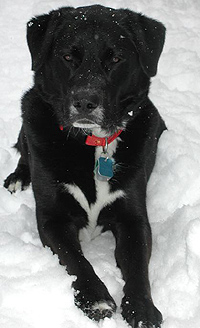
Black dog syndrome or big black dog syndrome is a phenomenon in which black dogs are passed over for adoption in favor of lighter-colored animals. Black cats are similarly reported to be subject to the same phenomenon.

Bo was a pet dog of the Obama family, the first family of the United States from 2009 until 2017. President Barack Obama and his family were given the male Portuguese Water Dog as a gift after months of speculation about the breed and identity of their future pet. The final choice was made in part because elder daughter Malia's allergies dictated a need for a hypoallergenic breed. Bo was occasionally called "First Dog". In August 2013, Bo was joined by Sunny, a female dog of the same breed.
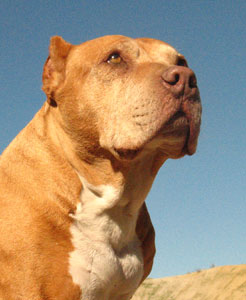
Daddy was an American Pit Bull Terrier integral to dog trainer Cesar Millan's work and his television series, Dog Whisperer with Cesar Millan. Daddy became known for his calm temperament, tolerance for smaller dogs and capacity for empathy.
Fatal dog attacks in the United States cause the deaths of thirty to fifty people each year. According to the National Center for Health Statistics, there were 468 deaths in the United States from being bitten or struck by a dog between 2011 and 2021. This is an average of 43 deaths annually, ranging from a low of 31 deaths in 2016 and a high of 81 deaths in 2021. Dogs killed more males than females during the tracking decade. Children between the ages of one to four are most often the victims, accounting for 29.4% of the fatalities from dog attacks in 2022; those under the age of seventeen accounted for 56.7% of all fatalities that year.

Pit Bulls & Parolees is an American reality television series on Animal Planet. The series, which began in 2009, focuses on the Villalobos Rescue Center, a rescue for dogs, specifically pit bull dogs.

Pound Puppies is an animated children's television series developed by Wendy Klein Moss, Nancy Steingard, Paul Germain and Joe Ansolabehere for the Hub Network. It premiered on October 10, 2010 in the United States as the first Hub "original series". It also aired on YTV in Canada and on Boomerang in the United Kingdom, Ireland and Australia. Produced by Hasbro Studios, it was the second series to adapt Pound Puppies into a cartoon format. Originally a property by Tonka, Hasbro acquired Tonka itself and currently manages Pound Puppies. The plot style and music were similar to the 1960s TV series Hogan's Heroes and to films like Stalag 17 and The Great Escape. The first seven episodes of the series were animated by 9 Story Entertainment, but DHX Media/Vancouver took over to animate the series from episode 8 onwards.

Status dog is a term used in the United Kingdom to describe a potentially dangerous or aggressive dog that is kept as a symbol of the owner's hard or tough image, to intimidate others, and possibly as a weapon. This idea has persisted through centuries, tracing back to Roman times. More recently, after news of vicious dogs mauling young victims, the Dangerous Dogs Act 1991 placed restrictions on the ownership and care of four types of dog ; while two further breeds, the Rottweiler and the Staffordshire Bull Terrier, are also widely perceived as status dogs. The UK has been taking steps to address the problem, starting with the Metropolitan Police establishing a dedicated Status Dog Unit in 2009.
DogsBite.org is a nonprofit organization that publishes accounts of and compiles statistics of dog bite related fatalities throughout the United States, victim testimonies, an overview of breed-specific legislation within the United States, and advocates for victims of dog bites by promoting breed-specific legislation as a means to reduce serious dog attacks. The organization provides statistics and information to news organizations and has filed amicus briefs in court cases related to breed-specific legislation. The organization has been criticized for publishing misleading or inaccurate information.
References
- 1 2 3 Yori, Roo (2017-12-06) [2014-07-30]. "My Pit Bull Never Snapped". Huffington Post (blog). Retrieved September 11, 2018.
- 1 2 "Nonfiction Book Review: Wallace: The Pit Bull Who Conquered a Sport, Saved a Marriage, and Championed a Breed—One Flying Disc at a Time by Jim Gorant". Publishers Weekly . Retrieved 10 September 2018.
- ↑ "Pit Smitten: Andrew Yori's Dog Wallace Defies Pit Bull Stereotype". The Humane Society of the United States. November 2012.
- 1 2 Kiger, Jeff (2013-08-23). "Wallace The Pit Bull passes on, but his story lives on". Post-Bulletin .
- ↑ "High Flyin' Disc Dogs". Modern Dog (picture caption). 6 May 2010. Retrieved September 10, 2018.
- 1 2 3 McCormick, Megan (2013-12-04). "The Incredible Story Of Wallace And Hector, Pit Bull Brothers Turned Breed Ambassadors". BuzzFeed . Retrieved September 10, 2018.
- ↑ "WALLACE by Jim Gorant". Kirkus Reviews . Retrieved 10 September 2018.
- ↑ Tinley, Scott (2012-09-07). "The Bonus: How Frisbee changed the life of a pit bull -- and his owners". Sports Illustrated . Retrieved September 10, 2018.
- ↑ St. John, Allen (2013-02-14). "In Praise Of Pit Bulls: Author Jim Gorant Speaks Out About Misunderstood Dogs And The Laws Aimed At Them". Forbes . Retrieved 10 September 2018.